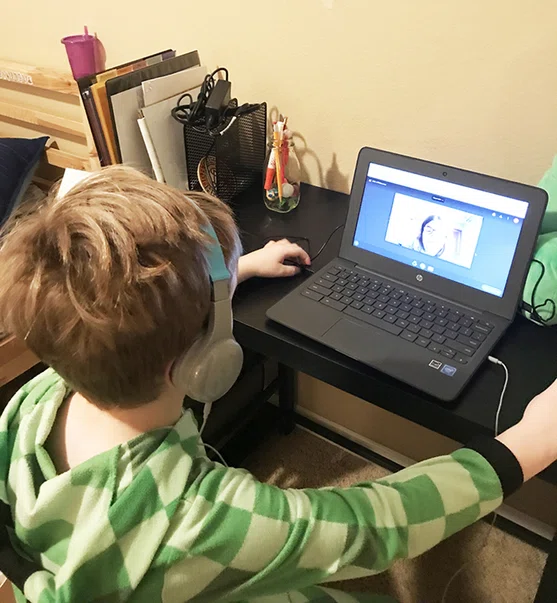The Parent Perspective: Technology has been essential for learning and connecting during school closures
The Parent Perspective: Technology has been essential for learning and connecting during school closures
May 25, 2020
The following was written by EdCal Editor Michelle Carl.
Technology has been essential for continuing to learn and connect during the COVID-19 closure of schools. It’s safe to say that if it weren’t for computers and the internet, no learning would be happening right now.
We humans need connections with other humans. Thanks to Zoom and other web conferencing platforms, teachers and students have been able to maintain that connection.
“The patience from teachers and the way they lead with positive reinforcement during Zoom classes is truly amazing to witness!” said one mom of a fifth grader.
Just seeing their teachers and their friends has been reassuring for my two sons, ages 7 and 5. For me, it’s been emotional to watch teachers get teary-eyed on Zoom expressing how much they miss their students.
Web conferences are also teaching our kids to show kindness, even in online settings. During one Zoom show and tell, our TK teacher made sure all students were clapping and responding to the classmate who just shared her favorite book.
That’s not to say distance learning has resulted in any less goofing off than normal.
“I had the joy of watching my son’s third grade class do a Google meeting,” one dad described for me. “None of the kids knew how to mute or pay attention. One of the kids was obviously playing video games during the meeting. The other kids were spamming the chat window.”
Thankfully, Zoom has given teachers the magic “mute all” button — a feature, unfortunately, not available to us parents in real life.
Web conferencing has also allowed students to demonstrate their knowledge. During small group Zoom calls with my second grader, his teacher has been able to give the group a math problem and watch them solve it to show they are understanding the concept.
While technology has some amazing abilities, it hasn’t been perfect. Right from the beginning, it became clear that our household needed more computers, a statement I’ve heard from other parents.
“One device is not enough for three students,” said a mom of a kindergartner and second and sixth graders. “We have a desktop, iPad (which we needed to go purchase) and a Chromebook we got from the school to use and we are constantly rotating depending on which assignment and meeting works best on that device.”
Luckily, our family was able to borrow two Chromebooks from our district (Roseville City School District). When my kids first got the Chromebooks, they were super excited. They even played learning games — on the weekend! It was prime cartoon time, but my kids were learning about place value! Now that we have a 1:1 ratio of people to computers in our house, distance learning has been much calmer.
Having the device is one challenge; using it to learn it is another.
“Trying to teach a second grader with learning challenges how to use a Chromebook and follow directions on a screen has been really hard,” said one mom. “As a parent, I have to do all the Chromebook navigation to lessons, videos, classwork, etc. It’s not something my second grader is ready for.”
Our district uses Clever, which has a single sign-on to unlock all of the apps the district uses. We are on the fourth week of distance learning as I write this, and my kids are getting pretty confident with logging in and getting to their lessons.
But doing the lessons independently is another story. I can hand my sons a tablet with ABC Mouse and they can do learning activities for 30 minutes, but they aren’t able to do the same with their Google Classroom work. I am having to set them up with an activity, which might last five minutes, and then stay with them in order to navigate to the next one. This becomes challenging when parents are trying to do their own work.
Some of the most successful lessons I’ve seen have been in Google Slides. The slide presentations have content including videos already embedded into them, allowing students to advance to the next slide easily. Others have interactive elements — students choose the plural form of a word from three options, for instance, and get a fun “reward” slide.
Even when the online lessons are fun, I’ve often ended up feeling like tech support. Right when I settle into working with one kid, the other one will say “Mom — it’s not working!” I see the need for intuitive design and being mindful of user experience in all of the apps educators choose. The easier it is for a kid to use, the more it will get used.
Technology has also offered some wonderful adaptations, allowing my 2nd grader to work on his writing in new ways. He struggles to write a paragraph that is organized and uses all the conventions like capitalization, proper spelling and punctuation. With the Talk to Type feature in Google Docs, he’s been able to speak what he wants to write, and then go back to fix misspellings and grammar.
This unplanned experiment in digital learning has taught us that school can absolutely be using more technology. And all of us — parents, teachers, and kids — are going to be so much better at it because of this.

The author’s son connects with his second grade teacher on Zoom.


